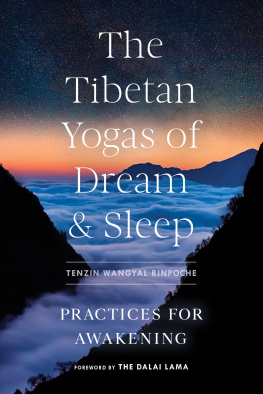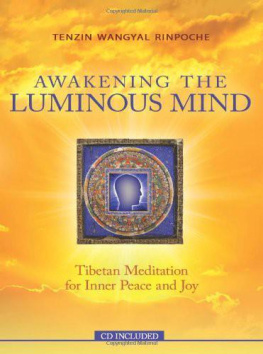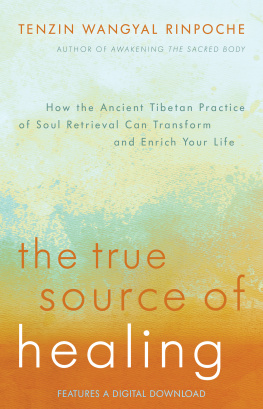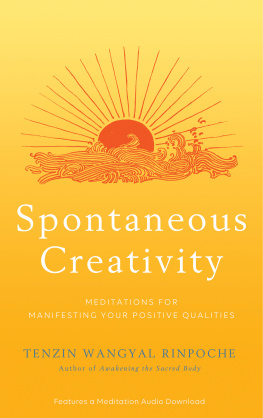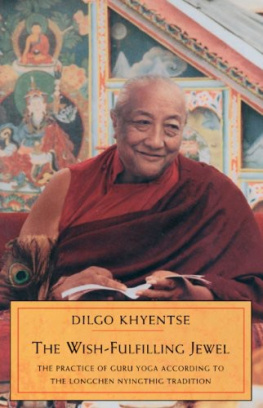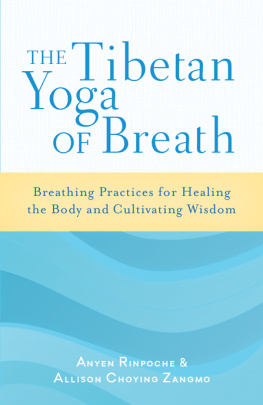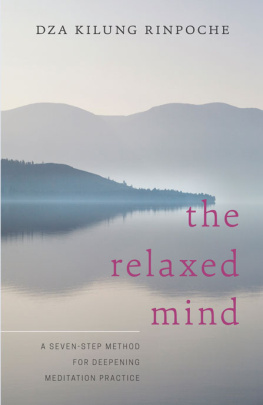In clear and lucid language, Tenzin Wangyal Rinpoche offers an amazingly rich array of traditional practices which, when practiced with a skilled teacher, can powerfully transform body, speech, and mind.
Jack Kornfield, author of A Path with Heart
Traditional as well as innovative, this booka complement to his other work and also outstanding on its ownopens to supremely important narratives, descriptions, and exercises to introduce us most deeply to our own bodies.
Anne Carolyn Klein, author of Heart Essence of the Vast Expanse: A Story of Transmission
Rinpoche does a great service in making these ancient and powerful teachings available to all of us. This insightful and practical book is an invaluable resource.
Sharon Salzberg, author of Real Happiness
With integrity and deep fidelity to these pinnacle teachings, Tenzin Wangyal shows us in very practical ways how we can touch our own depths and unlock the peace, confidence, warmth, and joy that lie within us all just beneath the surface.
Reginald Ray, author of Touching Enlightenment
Tenzin Wangyal Rinpoches latest book gives readers practical exercises from the Tibetan Bn tradition for working with and transforming what he calls pain body, pain speech, and pain mind. Treating each of these distinct domains of the individual as a whole, the author introduces practices of physical movement for the body, healing sounds and mantra for the speech, and visualizations and breathing techniques for the mind. This is done with a delicate balance of Bn Dzogchen technical terms such as the body of light and nine pranas juxtaposed with the authors anecdotes and analogies. For instance, Tenzin Wangyal writes how Micky Rourkes character Randy The Ram in the film The Wrestler exemplifies someone characterized by the pain body. The book contains numerous instructive photos, tables, and figures.
Buddhadharma
Bn Master Tenzin Wangyal Rinpoches Tibetan Yogas of Body, Speech, and Mind shows readers a variety of teachings and practices related to these three doors to enlightenment. Among highlights are: Dzogchen practices to achieve the body of light, mantras that provide healing through sounds, and energy practices to enhance clarity of mind. Some of the most compelling reading is provided by his discussion of sound. A chapter on speech includes teachings that range from the readily accessible... to the esoteric.... While Tenzin Wangyal encourages the reader to be skillful when deciding which practices we should usechoosing the right doorhe is also careful to remind us that body, speech, and mind are closely related. Unfortunately, the way we often sense their connection is through pain.
Tricycle
ABOUT THE BOOK
Understanding how our actions, words, and thoughts interact enhances our ability to progress in spiritual practice and brings us closer to self-realization. In a warm, informal style, Tenzin Wangyal Rinpoche opens up Tibetan meditation practice to both beginners and experienced students, placing as much emphasis on practice as on knowledge. Depending on the sources of the problems in our lives, he offers practices that work with the body, speech, or the minda collection of Tibetan yoga exercises, visualizations, sacred sound practices, and spacious meditations on the nature of mind. Together, he says, knowledge and regular meditation practice can alter our self-image and lead to a lighter, more joyful sense of being. The stillness of the body, the silence of speech, and the spacious awareness of mind are the true three doors to enlightenment.
TENZIN WANGYAL RINPOCHE, a lama in the Bn tradition of Tibet, presently resides in Charlottesville, Virginia. He is the founder and director of Ligmincha Institute, an organization dedicated to the study and practice of the teachings of the Bn tradition. He was born in Amritsar, India, after his parents fled the Chinese invasion of Tibet. He received training from both Buddhist and Bn teachers, attaining the degree of Geshe, the highest academic degree of traditional Tibetan culture. He has been in the United States since 1991 and has taught widely in Europe and America.
Sign up to receive inspirational Tibetan Dharma quotes and special offers from Shambhala Publications.

Or visit us online to sign up at shambhala.com/edharmaquotes.
Tibetan Yogas of Body, Speech, and Mind
Tenzin Wangyal Rinpoche
Edited by Polly Turner
S NOW L ION
Boston & London
2013
Snow Lion
An imprint of Shambhala Publications, Inc.
Horticultural Hall
300 Massachusetts Avenue
Boston, Massachusetts 02115
www.shambhala.com
Copyright 2011 Tenzin Wangyal Rinpoche
All rights reserved. No portion of this book may be reproduced by any means without prior written permission from the publisher.
ISBN-10: 1-55939-380-7
ISBN-13: 978-1-55939-380-5
Library of Congress Cataloging-in-Publication Data
Wangyal, Tenzin.
Tibetan yogas of body, speech, and mind / Tenzin Wangyal Rinpoche ; edited by Polly Turner.
p. cm.
Includes index.
eISBN 978-1-5593-9721-6
ISBN-13: 978-1-55939-380-5 (alk. paper)
ISBN-10: 1-55939-380-7 (alk. paper)
1. YogaBon (Tibetan religion) I. Turner, Polly, 1953- II. Title.
BQ7982.2.W35 2011
299.54dc22
2011010775
This book is dedicated to my teacher Yongdzin Tenzin Namdak Rinpoche
Contents
F IGURES
P LATES
T ABLES
Publishers Note
This book contains diacritics and special characters. If you encounter difficulty displaying these characters, please set your e-reader device to publisher defaults (if available) or to an alternate font.
W HEN I was a young monk in Dolanji, India, nearly every moring for three years I would join a small group of older students in the house of my root teacher Lopn Sangy Tenzin Rinpoche and listen to his explanations from the Oral Transmission of Zhang Zhung ( Zhang Zhung Nyen Gy ).
Lopn Sangy Tenzin lived a very simple, solitary life in his isolated residence, seldom even leaving his bedroom. Yet, he was considered by many to be the greatest Bn scholar of his generation. Lopn delivered the dzogchen teachings of the Oral Transmission in a very clear, direct, and strict manner, rarely allowing even one question. It was hard work, but it was wonderful, too.
For eleven years at the Bn Dialectics School of Menri Monastery, I engaged in rigorous training in epistemology, cosmology, sutra, tantra, and dzogchen under the guidance of Lopn and other masters from the Bn and Buddhist schools of Tibet. Back then I always assumed that when it came time for me to teach I would duplicate the traditional presentation, moving chapter by chapter and point by point through the ancient texts, just as Lopn and countless other masters over the centuries had done before me. But once I attained my gesh degree and began to teach in Europe and then in the United States, I was troubled to find a general lack of committed engagement among my Western students.
Some students would base their decision to come to a retreat not on the opportunity to be with me and receive the precious dharma but rather on the specific topic I would be teaching about. If they had already received those teachings or if the teaching was on sutra or tantra and they wanted dzogchen, they might decide not to come. Others would come and tell me how connected they felt to the teachings and to me, but after a few months or years, I would never see them again. One student whom I hadnt seen in several years returned to greet me and announced that he had found skydiving. Somehow he had progressed from the profound, esoteric dzogchen meditation practice of sky gazing to the sport of skydiving!
Next page

